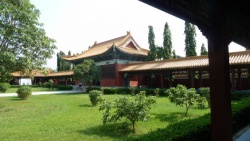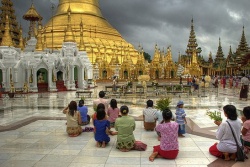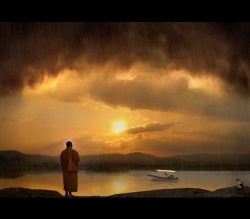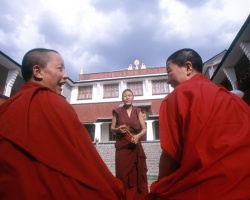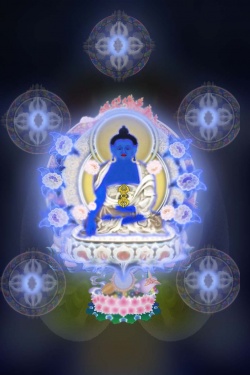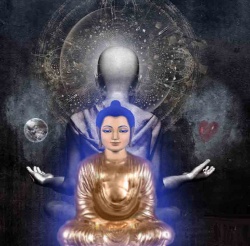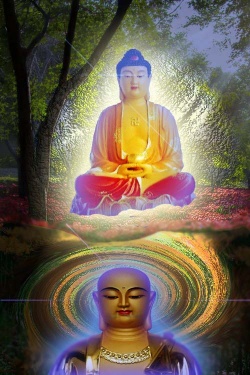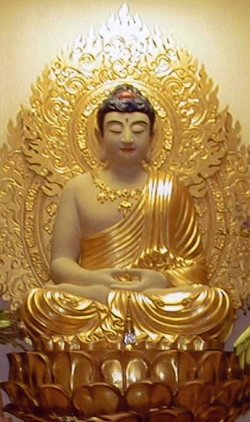Violence and War
The first of the five fundamental Buddhist precepts is "Avoid killing any living thing." That is because from the Mahayana perspective, all beings have been our mothers at one time, but even if you have difficulty relating to that, surely
All tremble at violence,
Life is dear to all.
Comparing others with oneself
One should neither kill nor cause others to kill.
~Dhammapada v. 130
How Does Killing Happen?
The three "poisons" that drive samsara are the cause of all harmful actions, to ourselves as well as to other sentient beings: Patrul Rinpoche, in The Words of My Perfect Teacher (rev. edition, Padmakara Translation Group, 102) is clear on this:
"A warrior killing an enemy in battle is an example of killing out of hatred. Killing a wild animal to eat its flesh or wear its skin is killing out of desire. Killing without knowing the consequences of right and wrong -- or, like certain tirthikas, in the belief that it is a virtuous thing to do -- is killing out of ignorance."
In Wartime
The Buddha is often shown analyzing conflict by examining the sources of it, and then showing how it is possible to remove or transform the causes. There is no dharma teaching that suggests that violence should be used to resolve conflict. In fact, it is said:
In times of war
Give rise in yourself to the mind of compassion,
Helping living beings
Abandon the will to fight.
In the Kutadanta Sutta, (Digha Nikaya V) he recommends non-violent policies as a wiser solution than war.
In another instance, he convinced Ajatasatru not to retaliate after his defeat at the hands of King of Kosala. In the battle, Ajatasatru had been captured alive. All his elephants, cavalry, chariots, and infantry were confiscated but he was released. When the Buddha heard about it from his monks, he said:
A man will go on plundering
So long as it serves his ends,
But when others plunder him
The plunderer is plundered.
The fool thinks fortune is on his side
So long as his evil does not ripen,
But when the evil ripens
The fool incurs suffering.
The Killer begets a killer;
One who conquers, a conqueror.
The abuser begets abuse,
The reviler, one who reviles.
Thus by the unfolding of karma,
The plunderer is plundered.
In the dispute between the Shakyas of Kapilavastu and the Koliyans over the use of the dam across the Rohini River during a time of drought, he rose into the air dramatically in order to intervene between the two sides to prevent bloodshed, and succeeded in reconciling them. (The account appears in a number of sutras and also the Vattaka Jataka.)
One of Buddha Shakyamuni's most vivid sermons is devoted to forbearance, tolerance and non-violence. In it he says:
Monks, as low-down thieves might carve you limb from limb with a double-handed saw, yet even then whoever sets his mind at enmity, for this reason, is not a doer of my teaching.
~ Kakacupama Sutta, Majjhima Nikkaya I: 28-29
Examples
The Dalai Lama, winner of the Nobel Peace Prize in 1989, is a vivid example of this commitment to peace. He said in his speech, "I believe all suffering is caused by ignorance. People inflict pain on others in the selfish pursuit of their happiness or satisfaction."
Dharma teaches, "Hatred will not cease by hatred, but only by love. That is the ancient law."
Many Buddhists have refused to take up arms under any circumstances, even knowing that they would be killed as a result. This refusal actually goes beyond the monastic code that permits self-defense, if it does not entail killing.
In Buddhist societies, governmental authorities are faced with the dilemma of how to keep the peace and protect citizens without being violent. One approach tries to address the source of social problems. Thich Nhat Hanh, chairman of the Vietnamese Buddhist peace delegation during the Vietnam War, supports a movement which shifts the emphasis of Buddhist practice from renunciation of the world to an emphasis on social involvement. The term "Engaged Buddhism" was coined by him.
BBCi, Religion and Ethics cites an anecdote about Thich Nhat Hanh's response to a criticism by a Vietnam veteran on his firm dedication to non-violence:
"You're a fool," said the veteran, "what if someone had wiped out all the Buddhists in the world and you were the last one left? Would you not try to kill the person who was trying to kill you, and in doing so save Buddhism?"
Thich Nhat Hanh answered patiently, "It would be better to let him kill
me. If there is any truth to Buddhism and the Dharma, it will not
disappear from the face of the earth, but will reappear when seekers of
truth are ready to rediscover it.
"In killing, I would be betraying and abandoning the very teachings I
would be seeking to preserve. So it would be better to let him kill me
and remain true to the spirit of the Dharma."
It is true, however, that one Jataka relates that in a former existence, the Buddha then captain of a ferryboat with 500 merchant -bodhisattvas on board, undertook to murder a pirate who planned to kill everyone in order to steal the cargo. The late Chagdud Tulku (d. 2003) wrote about this incident in "Bodhisattva Warriors:"
The captain, a bodhisattva himself, saw the man's murderous
intention and realized this crime would result in eons of torment for
the murderer. In his compassion, the captain was willing to take
hellish torment upon himself by killing the man to prevent karmic
suffering that would be infinity greater than the suffering of the
murdered victims. The captain's compassion was impartial; his
motivation was utterly selfless.
But also in this teaching, Chagdud Tulku provided the example of how to deal with the current conflict, saying:
. . . I pray that this war will prevent greater wars, greater suffering, and that those opposed to war develop the skills to bring about authentic peace. We cannot fully discern the motivation of any participants involved in the conflict, but it is unlikely that many have the ability to bring about ultimate liberation for friends and enemies alike, or that they will be able to sustain the bodhisattva's impartial compassion as they engage in conflict.
What we can know is our own minds. We can adhere to Buddhist ideals in our activities, whether we are combatants, protestors, decision-makers or concerned witnesses. We can pray that whatever virtue there is in the situation prevails, that genuine peace be established. The Buddha has taught that throughout countless lifetimes all beings have been our parents and have shown us great kindness. Now they have fallen under the sway of the mind's poisons of desire, anger, ignorance, and they suffer terribly. Could we exclude any from our compassion any more than the sun could exclude any from the warmth and radiance of its rays [?]
The Martial Arts
Buddhist monks are famous for having developed various forms of martial arts. The Shaolin order is the best known, yet initially their methods developed in order to balance the demands of a life of meditation in relatively austere and harsh surroundings. From this training, the person also acquires insight into the very nature of violence.
This, and other lineages that train the body, absolutely forbids the monk from being the aggressor. The student is taught to use various techniques to avoid harm to the opponent and to himself/herself. The fundamental instruction is always to use only the minimum defensive force. Techniques range from how to block various kinds of blows, to the use of paralyzing holds and, only in the face of extreme violence, the judicious use of a knockout.
Buddhist Violence
Buddhists do not always live up to the highest principles. Individuals are not always mindful of the precepts and there have been instances where groups and governments consider that violence and even war are necessary.
In the 14th century, the uprising that eventually evicted the Mongols from China was led by Buddhists.
Japanese Buddhist monks were known to have trained Samurai warriors in meditation and other, less peaceful, skills. In 1942, during the period of Japanese aggression, Zen master Sawaki Kodo (1880–1965) did not hesitate to write:
"It is just to punish those who disturb the public order. Whether one
kills or does not kill, the precept forbidding killing [is preserved]. It is
the precept forbidding killing that wields the sword. It is the precept
that throws the bomb."
The Chinese takeover of Tibet was not without its resistance movements. In one notable event, a violent uprising was led by the women of east Tibet. There are many who find it difficult not to admire this action, considering the circumstances.
The Buddhists of Ladakh refuse to flee from Kashmiri insurgents, even if they must fight. Should they succumb to eviction as have most of the brahmins there?
And sadly, in Sri Lanka a civil war between the mostly Buddhist Sinhalese and the Hindu Tamil minority cost 50,000+ lives.
And On and On and On
_____________________________________________________
Ajatasatru: Prince of Magadha, "Born with a grudge" (Tibetan: Ma-kye-dra) conspired with Buddha's malicious cousin to imprison his father, King Bimbisara, who died as a consequence. Later, realizing the enormity of this sin, he took Refuge and through his own efforts purified his negative karma, and some say he became an arhat.
After Ajatasatru was defeated by Kosala, he married that king's daughter. He schemed for 16 years to break the Vajjian Federation for reasons which differ according to whether the source is Buddhist or Jaina. (Vajji king, Cetaka, was the Jain saint Mahavira's uncle.) He eventually accomplished his political ends by planting his own minister, who fomented discord. Finally, the Vajjian king was executed, and Ajatasatru acquired that territory.
